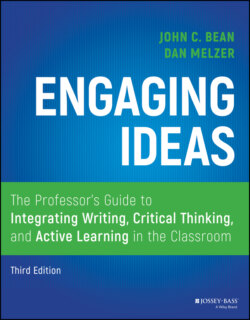Читать книгу Engaging Ideas - John C. Bean - Страница 37
Step 4: Develop a Repertoire of Ways to Give Critical Thinking Tasks to Students and to Coach Critical Thinking
ОглавлениеOnce you have developed a stockpile of critical thinking problems based on your course's subject matter, you can choose from dozens of ways to integrate them into your course. This book presents numerous options for giving critical thinking problems to students. These include the following:
Problems as formal writing assignments. Formal writing assignments, which require revision and multiple drafts, keep students on task for extended periods and are among our most powerful tools for teaching critical thinking. They can range in length from one‐paragraph microthemes (see chapter 4) to major research projects within a disciplinary genre (see chapter 10). As these chapters show, effective academic assignments usually require that the student develop and explore a disciplinary problem or propose and support a thesis or test a hypothesis in response to a problem. Such problem‐centered assignments, which are primarily argumentative or analytical, are more effective for developing critical thinking than topic‐centered assignments, which students often interpret as asking for information (“Write a research paper on one of the following topics.”).
Problems as thought‐provokers for exploratory writing. Although students usually write only a few formal papers for a course, they can do behind‐the‐scenes exploratory writing on a daily basis. Chapters 2 and 5 provide a rationale for this kind of low‐stakes writing, which is a seedbed for generating and growing ideas. Exploratory writing records the actual process of critical thinking while simultaneously driving it forward. Perhaps more than any other instructional tool, exploratory writing transforms the way students study for a course because it can make active critical thinking about course subject matter part of each day's homework. Chapters 5 and 6 give numerous suggestions for integrating exploratory writing into a course, ranging from various kinds of journals or thinking pieces to postings on electronic discussion boards.
Problems as small‐group tasks. Disciplinary problems make powerful collaborative learning tasks. Small groups can be given a set time to brainstorm possible solutions to a problem or to seek a best solution by arriving at a consensus or a reasoned “agreement to disagree.” In a plenary session, groups report their solutions and present their justifying arguments using appropriate reasons and evidence. The instructor usually critiques the groups' solutions and often explains how experts in the discipline (for whom the teacher is spokesperson) might tackle the same problem. During plenary sessions, the instructor models and coaches disciplinary ways of making arguments, also attending to the generic critical thinking skills of looking at the available evidence and considering alternative views. Chapter 8 focuses on the uses of small groups to promote critical thinking.
Problems as starters for class discussions. Discussion classes can begin with one or two critical thinking problems written on the whiteboard or posted in advance on an electronic discussion board as questions of the day. The teacher guides the discussion, encouraging students to appreciate and manage complexity. (If students have addressed these questions the night before in an exploratory thinking piece, they will be more prepared for class discussion.) Other ways to get students actively addressing critical thinking problems include classroom debates, panel discussions, and fishbowls. See chapter 9 for suggestions on bringing more critical thinking into lectures and class discussions.Besides giving students good problems to think about, teachers need to critique students' performances and to model the kinds of critical thinking they want students to develop. This book suggests numerous ways that teachers can coach critical thinking, including critiquing solutions developed by small groups, guiding class discussions to deepen complexity, inviting alternative points of view, writing comments on student drafts, holding conferences, sharing their own autobiographical accounts of their own thinking and writing processes, discussing strengths and weaknesses of sample papers, breaking long assignments into stages, and stressing revision and multiple drafts. An equally important aspect of coaching critical thinking is to provide a supportive, open classroom that values the worth and dignity of all students. When students actively use a course's new concepts, ideas, and information to address authentic problems, they engage course material on a deep level.
